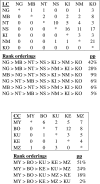Food site residence time and female competitive relationships in wild gray-cheeked mangabeys (Lophocebus albigena)
- PMID: 19633733
- PMCID: PMC2714887
- DOI: 10.1007/s00265-009-0805-7
Food site residence time and female competitive relationships in wild gray-cheeked mangabeys (Lophocebus albigena)
Abstract
Authors of socioecological models propose that food distribution affects female social relationships in that clumped food resources, such as fruit, result in strong dominance hierarchies and favor coalition formation with female relatives. A number of Old World monkey species have been used to test predictions of the socioecological models. However, arboreal forest-living Old World monkeys have been understudied in this regard, and it is legitimate to ask whether predominantly arboreal primates living in tropical forests exhibit similar or different patterns of behavior. Therefore, the goal of our study was to investigate female dominance relationships in relation to food in gray-cheeked mangabeys (Lophocebus albigena). Since gray-cheeked mangabeys are largely frugivorous, we predicted that females would have linear dominance hierarchies and form coalitions. In addition, recent studies suggest that long food site residence time is another important factor in eliciting competitive interactions. Therefore, we also predicted that when foods had long site residence times, higher-ranking females would be able to spend longer at the resource than lower-ranking females. Analyses showed that coalitions were rare relative to some other Old World primate species, but females had linear dominance hierarchies. We found that, contrary to expectation, fruit was not associated with more agonism and did not involve long site residence times. However, bark, a food with a long site residence time and potentially high resource value, was associated with more agonism, and higher-ranking females were able to spend more time feeding on it than lower-ranking females. These results suggest that higher-ranking females may benefit from higher food and energy intake rates when food site residence times are long. These findings also add to accumulating evidence that food site residence time is a behavioral contributor to female dominance hierarchies in group-living species.
Figures




Similar articles
-
Reproductive tactics influence cortisol levels in individual male gray-cheeked mangabeys (Lophocebus albigena).Horm Behav. 2009 Jan;55(1):210-6. doi: 10.1016/j.yhbeh.2008.10.004. Epub 2008 Oct 21. Horm Behav. 2009. PMID: 18996388
-
Social factors increase fecal testosterone levels in wild male gray-cheeked mangabeys (Lophocebus albigena).Horm Behav. 2011 Apr;59(4):605-11. doi: 10.1016/j.yhbeh.2011.02.018. Epub 2011 Mar 3. Horm Behav. 2011. PMID: 21376722
-
Do Dispersing Monkeys Follow Kin? Evidence from Gray-cheeked Mangabeys (Lophocebus albigena).Int J Primatol. 2011 Apr;32(2):474-490. doi: 10.1007/s10764-010-9483-6. Epub 2011 Jan 5. Int J Primatol. 2011. PMID: 21475401 Free PMC article.
-
Taxonomic assessment of the allopatric gray-cheeked mangabey (Cercocebus albigena) and black mangabey (C. aterrimus): Comparative socioecological data and the species concept.Am J Primatol. 1987;12(2):181-187. doi: 10.1002/ajp.1350120205. Am J Primatol. 1987. PMID: 31973509 Review.
-
[The social structure of primates].Anthropol Anz. 1985 Jun;43(2):97-164. Anthropol Anz. 1985. PMID: 3927823 Review. German.
Cited by
-
The role of threats in animal cooperation.Proc Biol Sci. 2011 Jan 22;278(1703):170-8. doi: 10.1098/rspb.2010.1241. Epub 2010 Aug 26. Proc Biol Sci. 2011. PMID: 20798110 Free PMC article. Review.
-
The importance of first impression judgements in interspecies interactions.Sci Rep. 2020 Feb 10;10(1):2218. doi: 10.1038/s41598-020-58867-x. Sci Rep. 2020. PMID: 32042066 Free PMC article.
-
Quantifying allo-grooming in wild chacma baboons (Papio ursinus) using tri-axial acceleration data and machine learning.R Soc Open Sci. 2023 Apr 12;10(4):221103. doi: 10.1098/rsos.221103. eCollection 2023 Apr. R Soc Open Sci. 2023. PMID: 37063984 Free PMC article.
-
Triadic male-infant-male interaction serves in bond maintenance in male Assamese macaques.PLoS One. 2017 Oct 18;12(10):e0183981. doi: 10.1371/journal.pone.0183981. eCollection 2017. PLoS One. 2017. PMID: 29045402 Free PMC article.
-
Trichromacy increases fruit intake rates of wild capuchins (Cebus capucinus imitator).Proc Natl Acad Sci U S A. 2017 Sep 26;114(39):10402-10407. doi: 10.1073/pnas.1705957114. Epub 2017 Sep 11. Proc Natl Acad Sci U S A. 2017. PMID: 28894009 Free PMC article.
References
-
- {'text': '', 'ref_index': 1, 'ids': [{'type': 'DOI', 'value': '10.1016/j.anbehav.2004.08.011', 'is_inner': False, 'url': 'https://doi.org/10.1016/j.anbehav.2004.08.011'}]}
- Adams ES (2005) Bayesian analysis of dominance hierarchies. Anim Behav 69:1191–1201
-
- {'text': '', 'ref_index': 1, 'ids': [{'type': 'DOI', 'value': '10.1146/annurev.es.05.110174.001545', 'is_inner': False, 'url': 'https://doi.org/10.1146/annurev.es.05.110174.001545'}]}
- Alexander RD (1974) The evolution of social behavior. Annu Rev Ecol Syst 5:324–383
-
- {'text': '', 'ref_index': 1, 'ids': [{'type': 'DOI', 'value': '10.1016/S0003-3472(83)80084-0', 'is_inner': False, 'url': 'https://doi.org/10.1016/s0003-3472(83)80084-0'}]}
- Appleby MC (1983) The probability of linearity in hierarchies. Anim Behav 31:600–608
-
- {'text': '', 'ref_index': 1, 'ids': [{'type': 'DOI', 'value': '10.1016/j.anbehav.2005.03.023', 'is_inner': False, 'url': 'https://doi.org/10.1016/j.anbehav.2005.03.023'}]}
- Archie EA, Morrison TA, Foley CAH, Moss CJ, Alberts SC (2006) Dominance rank relationships among wild female African elephants, Loxodonta africana. Anim Behav 71:117–127
-
- {'text': '', 'ref_index': 1, 'ids': [{'type': 'DOI', 'value': '10.1098/rspb.1999.0687', 'is_inner': False, 'url': 'https://doi.org/10.1098/rspb.1999.0687'}]}
- Barrett L, Henzi SP, Weingrill T, Lycett JE, Hill RA (1999) Market forces predict grooming reciprocity in female baboons. Proceedings of the Royal Society of London, Series B 266:665–670
